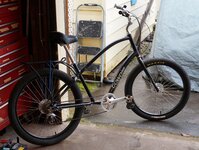eddywanderer
New Member
- Region
- USA
. . . some slightly geekish DIY electromechanical engineering questions for you wrench-and-voltmeter-wielding risk takers out there:
Old(er) age, a fixed income and the need of exercise having reduced me from midlife-crisis crotch rockets to sedate e-cruiser bikes, I have one definite project and one under consideration.
A first-generation (I think) high-bar Townie Electra, 36V / "250W" (RMS or peak?) planetary gear hub motor, cheapo 7-speed pedal drive train, mechanical disk brakes, in super-good condition, freshly re-rubbered with lower-rolling-resistance Maxxis road tires. Acquired late last year, so only got a little riding time in, enough to see that I love it despite being a bit feeble on top speed for longer rides.
Where in blazes is the pulse generator on this thing? Web searching yields a huge assortment of pretty much the same deal everywhere - usually a magnet clamped to a spoke and a corresponding inductive pickup coil attached to some stationary frame location. Examined every centimeter of the bike until blue in face, found zippity-squat. Nor any indication of the pieces having already been removed. Do some of these hub-drive bikes have the speed sensor built into the hub? Or could it be that a class 1 bike simply doesn't have enough power to warrant it? But if that's the case, how would it get information necessary for pedal assist synchronization?
There is one mysterious little 2 or 3-conductor wire that goes up inside the bottom bracket from what appears to be something electronic integrated with the battery holder. Could this model of bike be getting its rotational reference from the crank instead of the rear wheel like everyone says is the usual case?
Additionally, how do you folks feel about doing a high-powered direct-drive / higher-wattage upgrade on this kind of machine, what with its robust frame that seems ideal for such tinkering? Or would I be better off doing a front-drive conversion from scratch (lacking the spendy funds for a mid-drive) on my other Townie, a somewhat more nicely appointed 9-speed with the weird "roller" brakes..?
Advance thanks to any and all for input on this stuff.
Old(er) age, a fixed income and the need of exercise having reduced me from midlife-crisis crotch rockets to sedate e-cruiser bikes, I have one definite project and one under consideration.
A first-generation (I think) high-bar Townie Electra, 36V / "250W" (RMS or peak?) planetary gear hub motor, cheapo 7-speed pedal drive train, mechanical disk brakes, in super-good condition, freshly re-rubbered with lower-rolling-resistance Maxxis road tires. Acquired late last year, so only got a little riding time in, enough to see that I love it despite being a bit feeble on top speed for longer rides.
Where in blazes is the pulse generator on this thing? Web searching yields a huge assortment of pretty much the same deal everywhere - usually a magnet clamped to a spoke and a corresponding inductive pickup coil attached to some stationary frame location. Examined every centimeter of the bike until blue in face, found zippity-squat. Nor any indication of the pieces having already been removed. Do some of these hub-drive bikes have the speed sensor built into the hub? Or could it be that a class 1 bike simply doesn't have enough power to warrant it? But if that's the case, how would it get information necessary for pedal assist synchronization?
There is one mysterious little 2 or 3-conductor wire that goes up inside the bottom bracket from what appears to be something electronic integrated with the battery holder. Could this model of bike be getting its rotational reference from the crank instead of the rear wheel like everyone says is the usual case?
Additionally, how do you folks feel about doing a high-powered direct-drive / higher-wattage upgrade on this kind of machine, what with its robust frame that seems ideal for such tinkering? Or would I be better off doing a front-drive conversion from scratch (lacking the spendy funds for a mid-drive) on my other Townie, a somewhat more nicely appointed 9-speed with the weird "roller" brakes..?
Advance thanks to any and all for input on this stuff.



